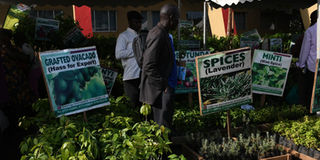Natural ways to grow a healthy garden

Choose healthy seedlings for a healthy garden. Check the roots and leaves before choosing a seedling. Photo by Edgar R. Batte
What you need to know:
- More gardeners are relactant to use artificial fertilisers or herbicides in their gardens because of their negative effects on our bodies. Here are some of the natural and effective options they are using in their healthy fruitful gardens.
Plants need care to blossom. Many times we are forced to give up on a garden that refuses to respond to our efforts. Other times we give in to the use of the many pesticides includeing insecticides, fungicides, herbicides, and other products that manufacturers market so well to kill rodents and bugs and diseases.
However, there are some non-toxic options that gardeners swear by that will leave your garden looking beautiful and healthy.
Know your soil type
Millicent Mpanga, a nursery owner, says problems usually start with the way the garden is prepared and also the quality of seeds planted. She urges people to get their soil tested before planting their gardens.
Most soil tests indicate nutrient deficiencies, soil acidity, the percentage of organic matter in your soil, and your soil’s texture. This will help you choose the right plants for your soil and the right fertiliser for them.
“When you are using guesswork to fertilise your plants, you run a risk of either giving them too much that can burn roots, reducing their ability to absorb water or too little thus starving them of nutrients. A soil test takes the guesswork out of the way,” she says.
Some gardeners are unaware that not all compost decomposes at the same rate. Some materials take longer than others. When you mix these materials you risk transferring live pathogens into your garden,” Mpanga says.
If any of these undecomposed materials had an infection, it will be introduced in the garden. She cautions against trying to make compost at home if you do not know how and to be on a safe side, to generally stay away from using yard waste as mulch under sensitive plants.
Choose seedlings carefully
Another way to have a healthy garden naturally, according to Mpanga, is by planting healthy seedlings to begin with.
When one goes to buy seedlings, they are often tempted by the tallest, equating height with health. Instead the focus should be on the plant’s roots system. Ask the seller to show you the roots, they should be firm, usually white, and spaced all over the root-ball,” she reveals.
Another important part to look at are the leaves. A healthy plant’s leaves should be a consistent strong solid colour.
The gardener recommends choosing a plant that has strong leaf growth preferably with new shoots and flower buds and has no evidence of disease. She notes that if a plant’s leaves look unusual, then it probably has a problem and it is best not to plant it in your garden.
Plant in the right spot
Wilson Kamanzi, a landscape designer, says successful gardening requires planting the right plants in appropriate spots.
“If you plant a shade-loving plant, in the sun, it will grow poorly and be easily attacked by diseases and insects. Alternatively planting a sun-loving plant in the shade will also affect its growth. A weak plant is susceptible to even the slightest of attacks from pests and diseases and will die easily,” Kamanzi notes.
Proper spacing is also important because plants that are crowded together tend to grow poorly due to competition for light, water, and nutrients. Diseases also spread easily when an infected leaf comes into contact with a healthy one.
Watering your garden is a good thing, but how one waters them makes a difference, according to Kamanzi.
“Choose watering methods that limit moisture on a plant’s leaves such as drip irrigation, this will deny pathogens water to move, grow, and reproduce. If you are watering by hand, hold the leaves out of the way as you water the roots,” he advises.
As a rule of thumb water only when necessary because waterlogged soil can rot some roots making them easy targets for the rotting fungi.
Manage pests and diseases
Horticultural oils such as neem oil and homemade sprays made with soap or vegetable oil are effective in killing insects because the oil coats their bodies and suffocates them.
Some people swear by garlic and chili pepper sprays, but they are more likely to repel insects than kill them; homemade versions are great deterrents, though.
One of the best weed killers is manual labour. Pulling weeds by the roots, adding mulch to flower beds, or laying biodegradable weed covers in the garden are alternatives to sprays.
Homemade sprays using Borax, salt, or vinegar are safe and effective options, too. However, these ingredients can harm other plants and damage soil, so be sure to just add the mix directly to weeds’ leaves without letting the solution soak into the ground.
Establish traps instead of spreading or spraying poison to get rid of pests.
Source: littlethings.com




